
Tech-over Mastering digital and procurement technologies to unsettle complexity
In addition to getting their digital house in order through data management and maintenance of technology building blocks, CPOs need to align their digital strategy with their organization's overall business strategy and take a proactive approach to adopting next-generation technologies.
In the last five years alone, the digital landscape for procurement has evolved considerably. CPOs who are able to stay abreast of these changes and take a true transformational mindset toward technology are able to deliver new value streams beyond just internal procurement process automation. They are bringing new analytic tools and “outside-in” digital services to stakeholders, not only for cost reduction but also for emerging customer-focused requirements such as socially responsible products and supply chains.
Learn more
Explore the survey
Download the full report or create a custom PDF
Subscribe to receive related content from Deloitte Insights
View the industry and regional survey results
Download the Deloitte Insights and Dow Jones app
View the overview webcast (live or replay)
Our survey findings reveal that while CPOs are at various stages of the digital maturity curve in their understanding and implementation of the digital procurement transformation (figure 1), complexity masters are better aligned with their organizations’ overall business strategies. Of the CPOs surveyed, 58 percent (and 74 percent of the complexity masters) are aligning their digital strategies to both their own objectives and to the overall business strategy. And they don’t do it alone, with 48 percent of organizations (55 percent for complexity masters) collaborating closely with their IT partners. CPOs can, when properly aligned, play a major role in assisting chief information officers (CIOs) to bring new capabilities to the organization, while remaining within budget and managing third parties to reduce risk and noncompliance. When combined, the CPO and CIO skill sets often make an ideal digital transformation partnership, with digitization and externalization working hand-in-hand to support more strategic digital capabilities.1 This digital evolution and transformation could not be clearer in the report.
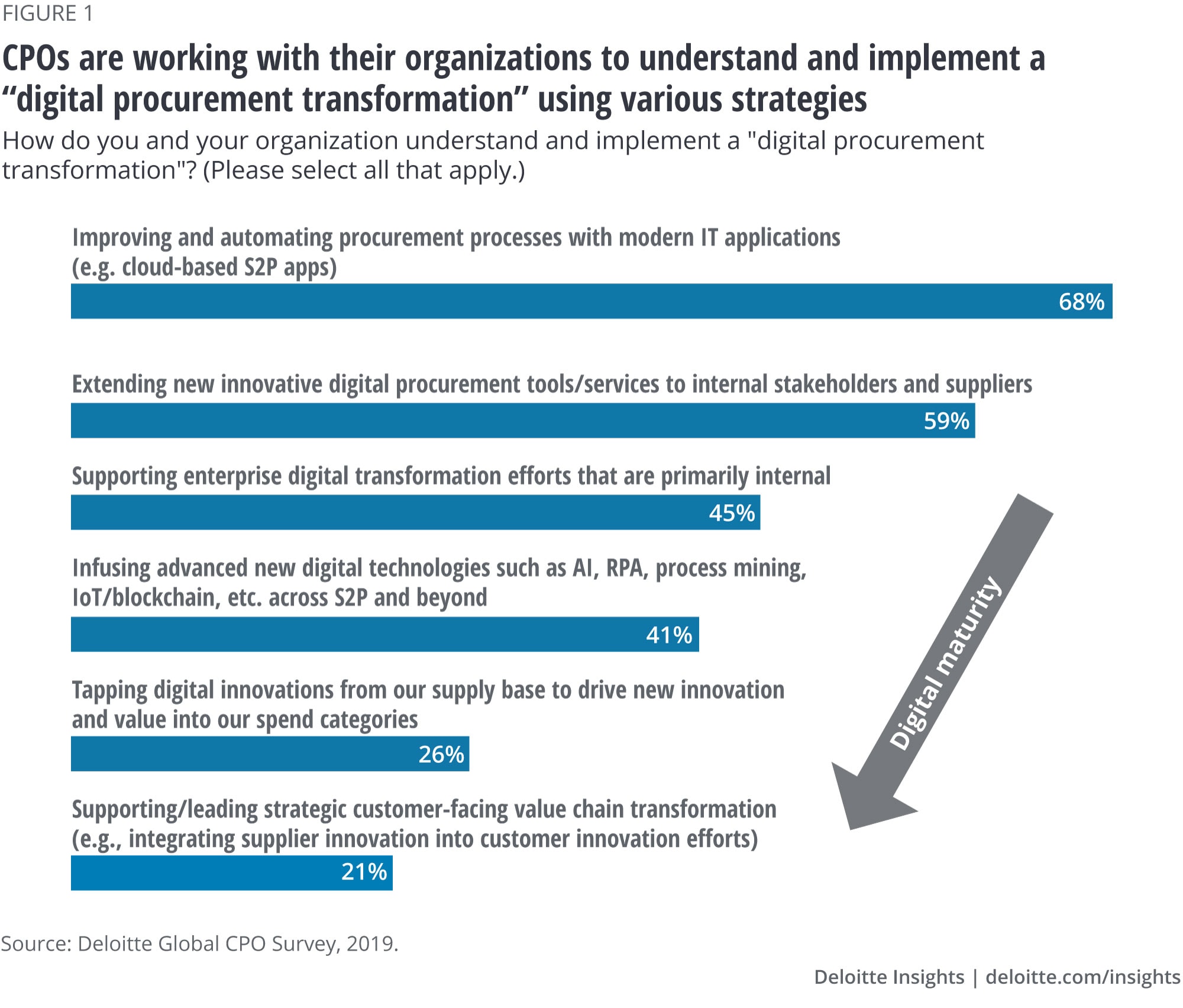
To help dismantle internal procurement complexity and improve internal performance, roughly two-thirds of CPOs are getting their house in order by implementing modern source-to-pay (S2P) applications that automate core workflows, which, done right, free them up to focus on even more strategic efforts. This embrace of technology is a work in progress, with the core set of S2P procurement activities—comprising requisitioning and ordering (e-procurement), invoice processing and payments (invoice-to-pay or procure-to-pay when combined with e-procurement), sourcing (RFx/auction), spend/supply analytics, and contract management—getting the most attention (figure 2).
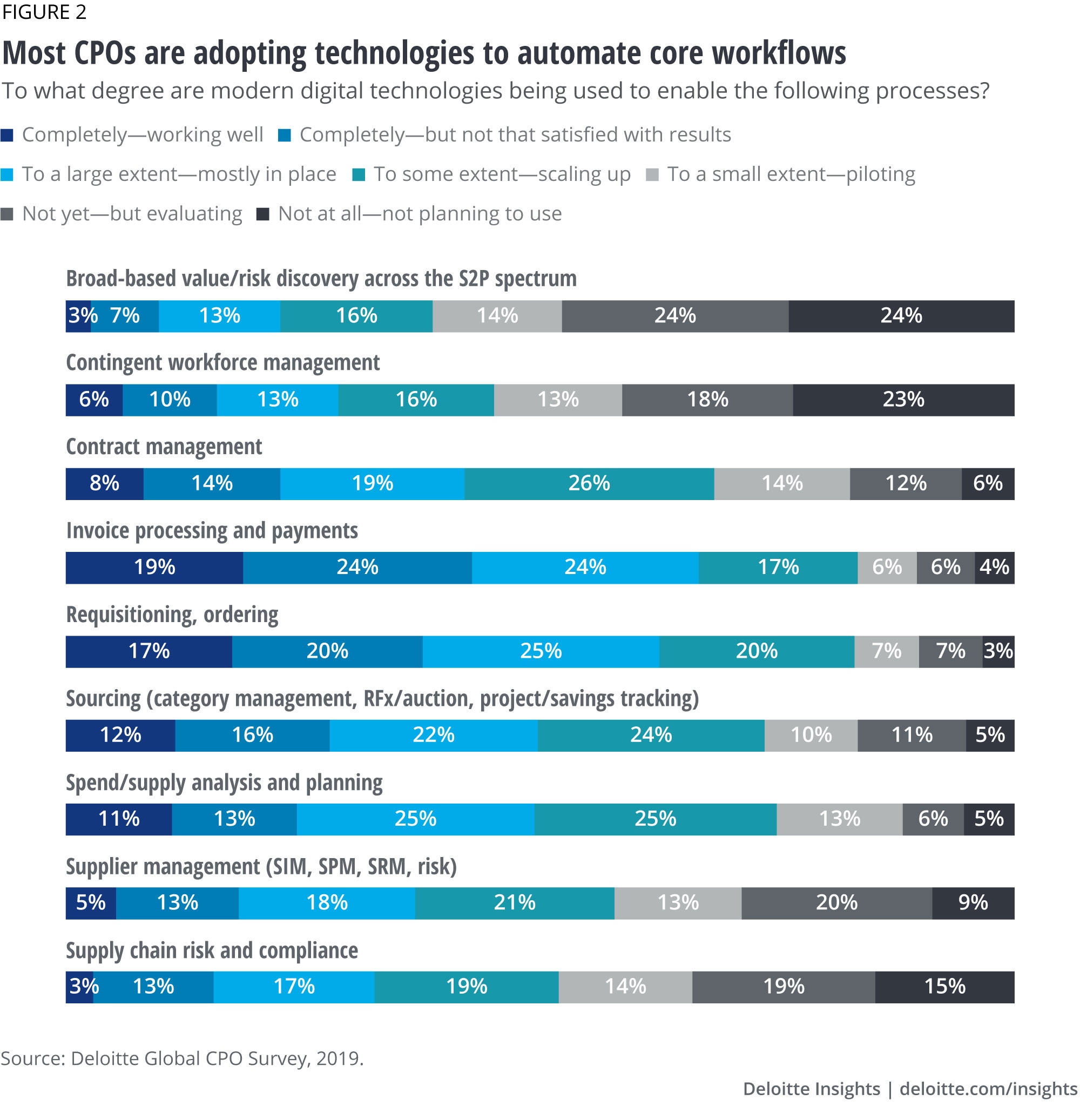
Complexity masters outperform the survey population on all these aspects, and have 30 percent higher adoption of “upstream” technology such as spend analytics, sourcing, supplier relationship management (SRM), contract management, and supply risk management. Interestingly though, a large percentage of companies that have fully implemented these modern technologies are not actually satisfied with the results (figure 3). In fact, shown in a different way, the results are sobering, especially for some of the more complex and strategic technology areas.
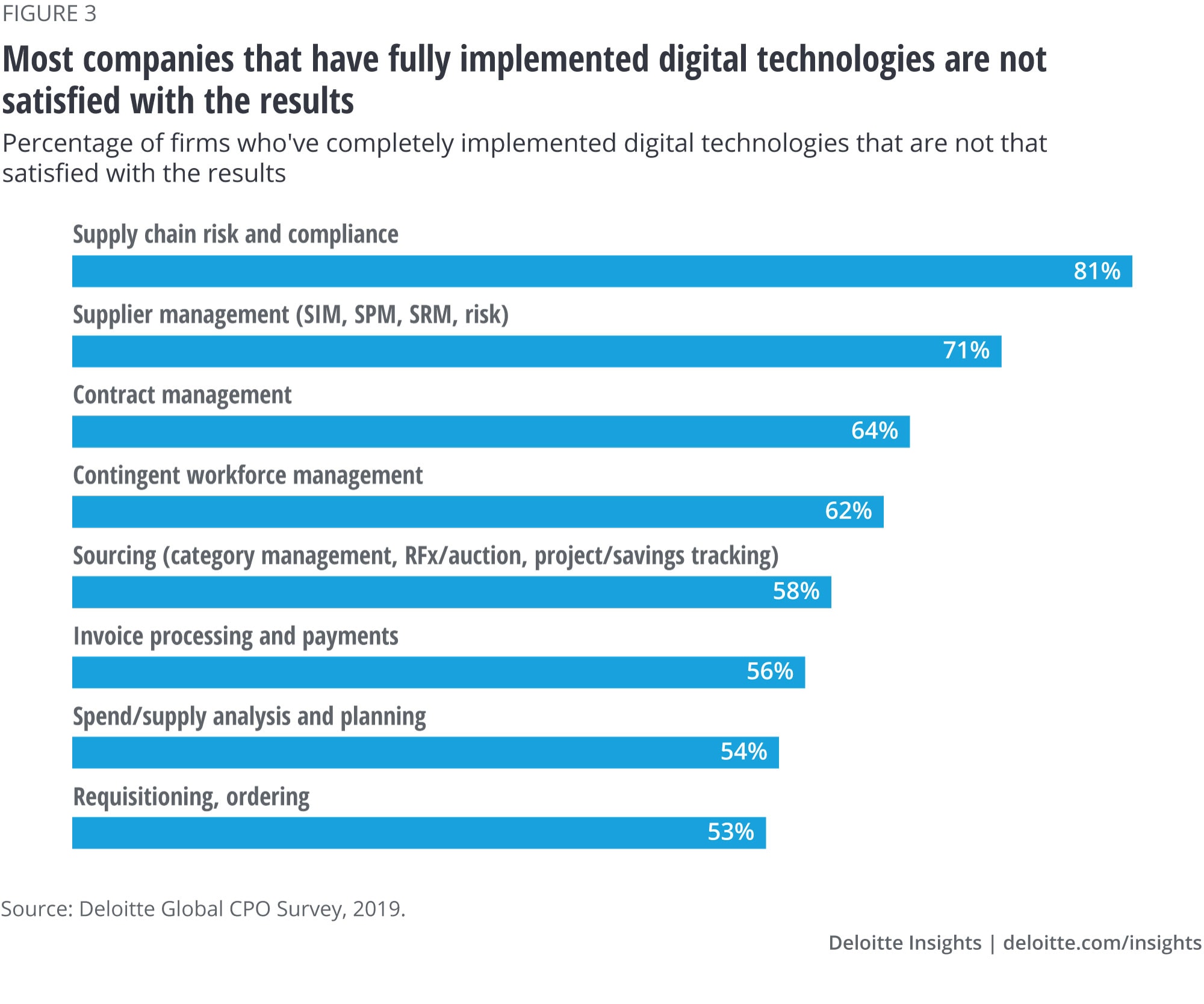
For the next two years, these core areas are expected to remain in focus. After analytics, which emerged as the top priority (59 percent), the most commonly cited areas of technology impact are related to upgrades of some element of the procurement applications landscape (figure 4). To that end, renewals for ERP platforms (35 percent), operational procurement tools (37 percent), and strategic procurement tools (37 percent) were viewed as the technology areas that would have the next-highest impact on businesses after analytics, which is a continuation of the trend from prior surveys.
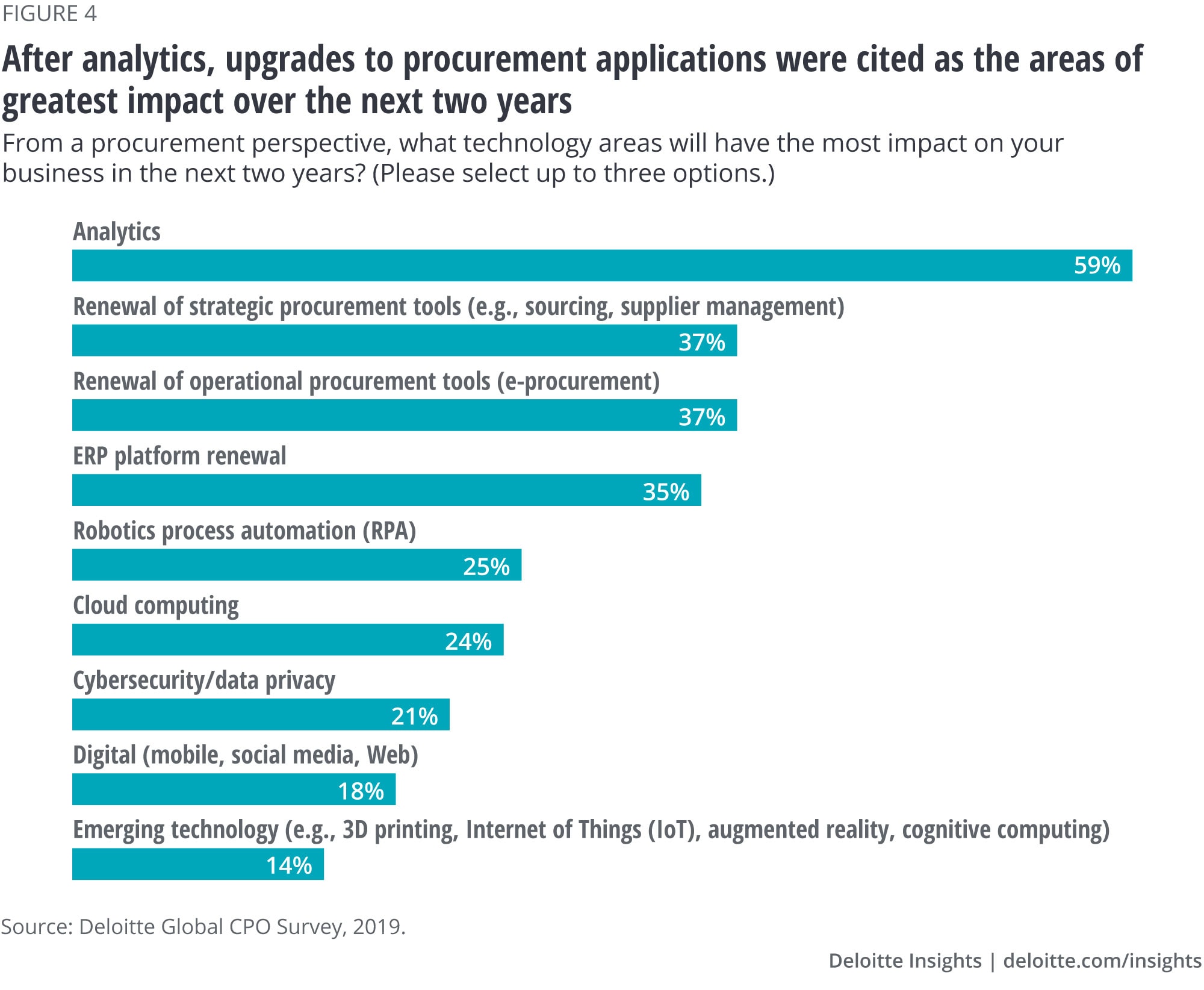
Despite the expected focus on core technologies in the near term, we do still expect the adoption and usage of disruptive technologies for strategic procurement applications in all key solution areas built on the foundation established by core technologies. For example, artificial intelligence (AI) is primarily taking two forms: predictive analytics built on machine learning, and also the deployment of “bots” that are beginning to transform robotic process automation (RPA) from its roots as a complex workflow automation toolbox.
Apart from the enterprise-level disruptive technologies, we also wanted to understand how these were more specifically being implemented within procurement to augment/disrupt mainstream procurement applications or create new avenues for value creation.2

Of these emerging technologies we analyzed, analytics and RPA show up clearly similar to the enterprise level, but “collaboration networks” are also being utilized that take different forms: supplier networks, e-marketplaces, supply chain networks, and narrow purpose-built networks for particular processes (e.g., risk/compliance focuses networks for supplier risk or environmental sustainability) or spend categories (figure 5). Beyond that, though, the more “bleeding edge” technologies appear to still be pursued by those CPOs who are either dabbling in the area (e.g., the 15 percent doing something in blockchain) or the 25 percent who are betting bigger (in areas such as AI/cognitive technologies). Customer satisfaction with these new tools, like most new markets, is a mixed bag (figure 6).

Much of this technology is increasingly being rolled out as standard functionality within commercially available procurement applications in areas such as spend classification, invoice automation, advanced contract analytics, and risk/fraud analytics. New vendors are also entering the procurement technology space and adding new sources of value via predictive analytics that leverage machine learning. Yet while this innovation is encouraging, there is also a downside. For all the value of new technologies able to reduce complexity and improve performance, the technologies themselves can add additional complexity through fragmented applications, higher integration costs, degraded data quality, and more vendors to manage (these challenges can also occur with mega vendors who’ve acquired these best-of-breed players).
The survey findings clearly indicated that CPOs were feeling the effects of digital complexity, a majority of whom pointed their fingers at data governance, especially given their focus on and deployment of analytics that shine a light on this dark issue (figure 7). Interestingly, the complexity masters struggled just as much, partially because their businesses are more complicated (e.g., large firms who’ve grown through M&A) and partially because of their willingness to adopt value-creating tools that may also introduce complexity of their own through data fragmentation. The survey findings also point toward “death by a thousand cuts,” the root causes for this data governance issue driving poor data quality—too many systems, old systems, poor standardization, and insufficient resources within procurement and IT alike (figure 8).
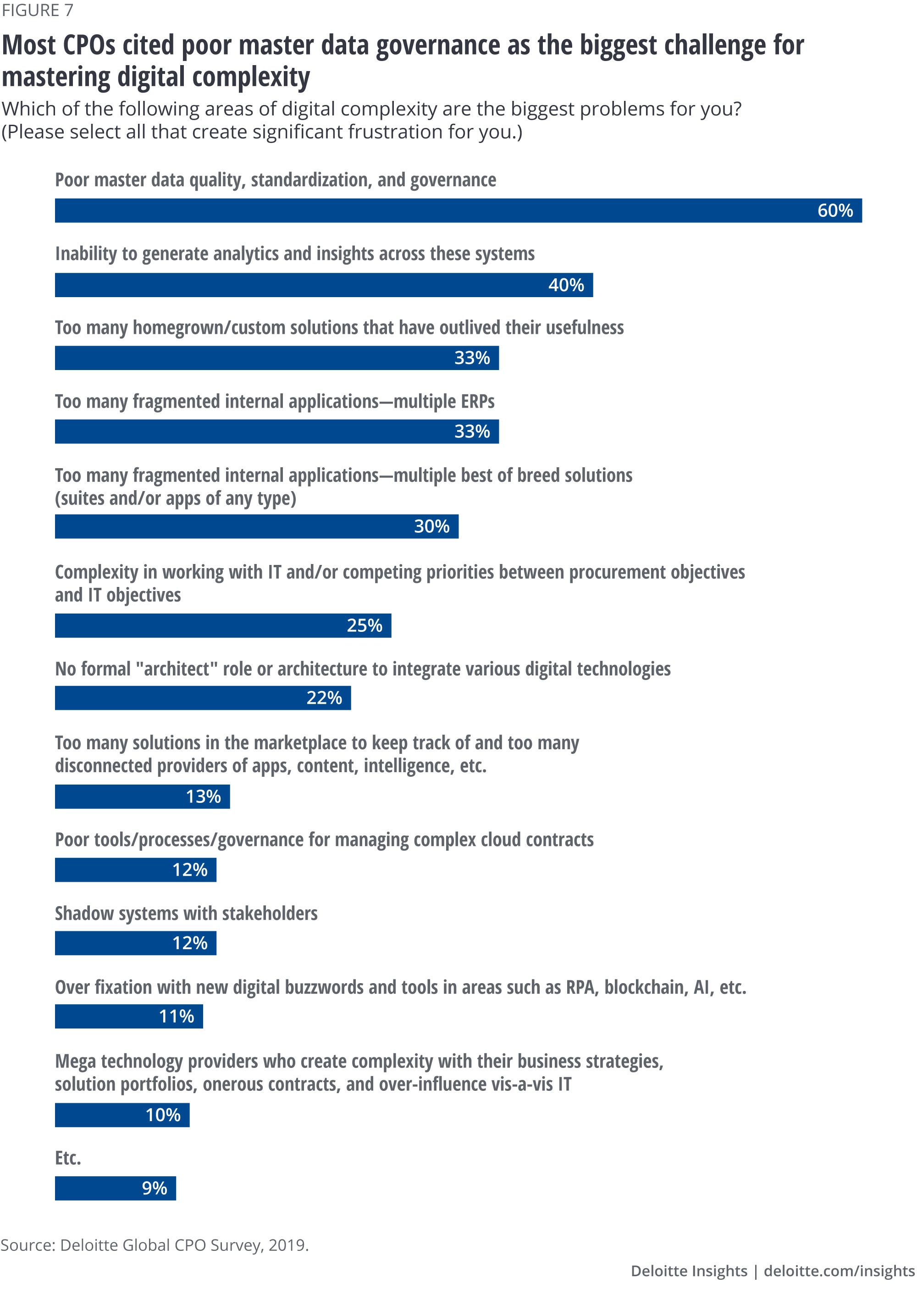

So what steps can CPOs take to address these root causes and help improve their mastery of digital? Here’s what they can do:
1. Define a bold digital vision, but execute iteratively on a strong foundation. An effective digital strategy is one that is both effective and doable, and takes many forms during the digital journey. Real impact will be customer-driven, but innovation may be hiding in plain sight with not only IT suppliers, but all suppliers pursuing digital business strategies. Sophisticated technologies such as predictive analytics using machine learning are compelling, but CPOs also need to get their digital house in order (e.g., master data quality) with some help from their IT partners.
2. Align procurement’s digital strategy with that of the organization. As with any transformation, CPOs will need to align to the digital vision (and business vision) of the executive team and board—and then deftly align those efforts with procurement’s own digital vision. Alignment with functional peers is also critical to not just manage their spend more effectively, but align with them in their enterprise-serving objectives (e.g., efficiency for finance, compliance for legal, innovation for R&D, Agile DevOps for IT, global scalability for shared services, etc.). Leading CPOs are helping stakeholders help themselves through improved self-service analytics, contracting, supplier management, and risk/compliance management.
3. Stay cognizant of the leading edge, but disciplined in your execution. While next-generation technologies such as AI and RPA are only beginning to find their way into procurement organizations, CPOs who fall behind the curve will likely not only miss value creation for themselves, but also can become less digitally savvy and relevant to stakeholders—including increasingly powerful suppliers. Suppliers can use digital to affect you for good or bad, so go on the offensive to both disrupt and collaborate. CPOs who want to realize their most ambitious goals will need to take a proactive and continuous approach to technology research—and often tap an experienced partner in the process.
© 2021. See Terms of Use for more information.
Read more
-
Building a cognitive digital supply network Article5 years ago
-
The rise of the digital supply network Article8 years ago
-
Synchronizing the digital supply network Article6 years ago
-
How blockchain enables the digital supply network Article6 years ago
-
The path to supply chain transparency Article10 years ago
-
The supply chain paradox Article6 years ago
















